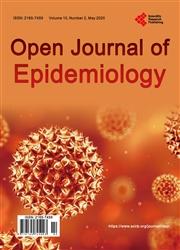Epidemiology of Low Birth Weight in the Lake Areas of Cotonou (Benin Republic)
引用次数: 0
Abstract
Introduction: Low birth weight is a significant public health problem world-wide, particularly in low-and-middle-income countries. This study aimed to investigate the epidemiology of low birth weight in the lake areas of Cotonou. Methods: A cross-sectional analytical study included 931 records of women who gave birth in 2022 in the Cotonou 1-4 health zone. Completed maternity records were included in this study, except for premature births and congenital malformations. Birth weight was the dependent variable. Sociodemo-graphic, obstetrical, preventive care and child-related data were collected us-ing a digitized form. These data were analyzed using SPSS software to determine the prevalence and factors associated with low birth weight using multiple logistic regression analysis. Results: The prevalence of low birth weight was 16.30%. Factors related to this prevalence were non-use of mosquito nets during pregnancy (OR = 2.72; CI: 1.275 - 5.805), twin pregnancy (OR = 9.97; CI: 3.869 - 25.696), previous abortion (OR = 1.61; CI: 1.034 - 2.515), low number of pregnancy (OR = 3.97; CI: 1.276 - 12.393), trimester of first ante-natal visit (OR = 3.47; CI: 1.821 - 6.638) and birth size less than 45 cm (OR = 5.98; CI: 2.965 - 12.083). Conclusion: The prevalence obtained from this study justifies the need to support pregnant women in this health zone. It is, therefore, essential to strengthen communication and health promotion strategies for women before, during, and after pregnancy.贝宁科托努湖区低出生体重流行病学调查
低出生体重是世界范围内的一个重大公共卫生问题,特别是在低收入和中等收入国家。本研究旨在调查科托努湖区新生儿低出生体重的流行病学。方法:横断面分析研究纳入了科托努1-4卫生区2022年分娩的931名妇女的记录。除早产和先天性畸形外,本研究包括完整的产妇记录。出生体重是因变量。社会人口统计、产科、预防保健和儿童相关数据通过数字化表格收集。使用SPSS软件对这些数据进行分析,采用多元logistic回归分析确定低出生体重的患病率和相关因素。结果:低出生体重儿患病率为16.30%。与该流行率相关的因素是:怀孕期间未使用蚊帐(OR = 2.72;CI: 1.275 - 5.805),双胎妊娠(OR = 9.97;CI: 3.869 - 25.696),既往流产(OR = 1.61;CI: 1.034 - 2.515),低妊娠率(OR = 3.97;CI: 1.276 - 12.393),第一次产前检查的三个月(OR = 3.47;CI: 1.821 - 6.638),出生尺寸小于45 cm (OR = 5.98;Ci: 2.965 - 12.083)。结论:从本研究中获得的患病率证明有必要支持该卫生区孕妇。因此,必须加强妇女在怀孕前、怀孕期间和怀孕后的沟通和健康促进战略。
本文章由计算机程序翻译,如有差异,请以英文原文为准。
求助全文
约1分钟内获得全文
求助全文

 求助内容:
求助内容: 应助结果提醒方式:
应助结果提醒方式:


